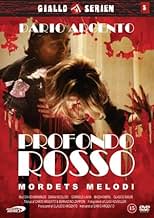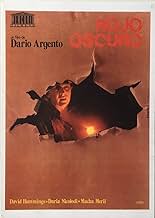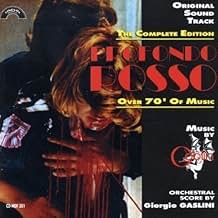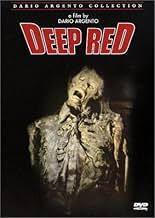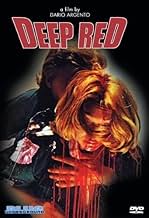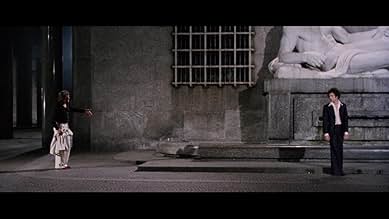एक जैज़ पियानोवादक और एक लतीफ़ेबाज़ पत्रकार एक रहस्य के पेचीदा जाल में फँस जाते हैं, जब जैज़ पियानोवादक अपनी आँखों से एक मनौवैज्ञानिक की क्रूर हत्या होते हुए देखता है।एक जैज़ पियानोवादक और एक लतीफ़ेबाज़ पत्रकार एक रहस्य के पेचीदा जाल में फँस जाते हैं, जब जैज़ पियानोवादक अपनी आँखों से एक मनौवैज्ञानिक की क्रूर हत्या होते हुए देखता है।एक जैज़ पियानोवादक और एक लतीफ़ेबाज़ पत्रकार एक रहस्य के पेचीदा जाल में फँस जाते हैं, जब जैज़ पियानोवादक अपनी आँखों से एक मनौवैज्ञानिक की क्रूर हत्या होते हुए देखता है।
- निर्देशक
- लेखक
- स्टार
- पुरस्कार
- 1 जीत और कुल 1 नामांकन
- Young Carlo
- (as Iacopo Mariani)
फ़ीचर्ड समीक्षाएं
And now we are in 2005 ,and thirty years after,with hindsight ,that most fruitful part of Agento's works which begins with "Ucello della piume di cristalli"(1967) and ends -roughly- with "opera" (1987)shows how the frequently demeaned director was ahead of his time.Argento's work is art-house film!If Mario Bava or John Carpenter are,he is too.
Influenced by the former (color,lighting effects,depth of field,baroque settings),he had a strong influence on the latter,particularly for his use of music,which may seem trite at first listening but literally grows on you and leaves you completely panting for breath.
There's really an Argentesque geometry,a non -Euclidean one,and few other directors ( Alfred Hitchcock , Roman Polanski ) know how to depict a place and make it threatening for his characters.Argento,who certainly read Gaston Leroux ("le fantôme de l'opera" ) when he was young,loves the opera houses(or theater)."profondo rosso" begins on a stage where some kind of medium (Macha Meril) sees horrible things.People who have read Hergé's adventures of Tintin will notice the similarities between this scene and those pages in "the seven crystal balls" where Tintin and Haddock are watching Mrs Yamilah in a music hall."Opera" 's first scene also would take place in a theater as if the director told us "it's only a movie,do not worry" before treating us to the delight of the best scene with birds since Hitchcock's eponymous movie.
The sense of space which Argento displays is mind-boggling: depth of field,high and low angle shots,impressive lighting effects.His characters become Tom Thumb lost in the huge forest:think of the ballerina ,running away through the corridors ("Suspiria" ),James Franciscus in the graveyard ("il gatto...) ,Tony Musante in the lighthouse (Ucello ...),or Irene Miracle in the basement (Inferno).Here it's a true anthology:almost every place is memorable,from the corridor where the drama is resolved to the house where bad things happened long ago ,from the isolated house in the country -where Argento uses condensation as only a Conan Doyle,a Gaston Leroux or an Ellery Queen could have done it- to the school where weird drawings might be the final clue.To top it all,there's a sensational scene in a corridor ,which recalls Orson Welles' "lady from Shanghai.A "they do it with mirrors" trick which is still very impressive today.
Not only Argento creates fear with his disturbing settings ,but he makes us also ill-at-ease with his supporting cast:the gay with the androgynous face,the little girl who seems to be out of Fellini's "Toby Dammit" (1968),and of course Clara Calamai who was famous in the fascist years (Visconti's "ossessione" from "the postman always rings twice").
What about the screenplay?Well,like all Argento's movies I mention ,it's far-fetched and derivative ("psycho" ,"Marnie" for the final flashback).But it's delightfully far-fetched and smartly derivative .When today's horror flicks screenplays consist of one page (maybe two)of clichés ,Argento's ones have always been painstaking and labyrinthine .
It is one of the best works in Argento's much debated but absorbing filmography.No horror movie buff can ignore him.
One of the best ¨Giallo¨with oneiric,effective esthetics packs lots of gore, guts and twists plots. This is a trademark terror work for the Horrormeister Argento with high tension quotient and equally high suspense by means of an ever-fluid camera that achieves colorful shots similarly to Giorgio De Chirico paintings. Noteworthy for intelligent edition work that tightens the mystery, glimmer use of color and distinctive utilization of shock images. Sometimes weak screenplay is added by nice but gory special effects by Carlo Rambaldi(ET).Screeching musical score by Goblin with stereophonic whispers combining to fortissimo soundtrack which help achieve incredible creepy moments.The terror pieces are well staged with eye-opening flair-play and contain obscure tracks to the denouement of the script.As trivia, Argento appears as murderer's hand. The motion picture is originally directed by Dario Argento, one of those film-makers(other examples are Mario Bava and Riccardo Freda ) who set off simple for frightening us to death. His period of biggest hits were the 70s when he directed the animals trilogy: ¨Four flies over gray velvet,The cat of nine tails, Bird with the crystal plumage¨, after he directed ¨Suspiria, Inferno, Tenebre¨ and of course ¨Deep red¨. This bloody fun plenty of graphic gore and weirdness may not be for all tastes but to be liked for Argento connoisseurs especially.
This film is written by Bernardino Zapponi ("Anal Paprika") and directed by Italian horror giant Dario Argento ("Tenebre", "Phenomena", "Inferno"). And I have to say this right away: as much as I love this film and think it's one of Argento's better pieces, why is it more highly rated than "Suspiria"? Internet Movie Database ranks this in their top 50 horror films, while "Suspiria" is mysteriously absent. "Suspiria" is the better film in almost every way. But anyway...
This film really excels in the writing of both characters and plot. The lead is very interesting (Marcus Daly) even though he really only acts as a catalyst for events and as a surrogate for the viewer, taking us where we couldn't go without a guide. Much of the plot is convoluted in the version I watched (the heavily edited English version, as I don't speak much Italian like my sister does), but still comes off as very well layered.
The gore is not as bad as some may have made it out to be. Even by 1970s standards, it's nothing really shocking. But it works. One scene, involving a woman killed with hot water, was well done. Another, with a man getting his teeth bashed out on the corner of a table, was not as gruesome as it could have been but was still painful to watch. The creepiest part (I actually felt uneasy) was when there was... a killer doll! It was just really creepy in the style of the presentation.
You can't talk about Argento's films without talking about the music. The band Goblin supplies the soundtrack (just like on "Suspiria") and does a fine job. One review found the music "annoying", and I can appreciate that sentiment. They do repeat the same songs over a lot, and the music isn't as blended in as it should be. But the songs themselves are moving and very good at burrowing into your subconscious. The theme to "Suspiria" is great (I have the soundtrack and it's awesome), and these songs are also really good. There's just something about them -- horror doesn't embrace music as often as it should. Think about the great horror themes, and try to imagine the films without them. Music is essential.
I look forward to someday seeing the Anchor Bay release of this film, as I'd love to see the edited parts. But I definitely recommend you see this if you have the chance. Sure, it's older and the quality isn't that stellar. Stop whining! Films should be judged on plot, acting and vision. Don't blame a director in the 1970s for not owning 1990s equipment. This one is a winner, although I have to disagree with the IMDb voters about it being the best Argento... maybe second best (which is still better than almost any other director out there).
क्या आपको पता है
- ट्रिवियाCo-writer Bernardino Zapponi said the inspiration behind the murder scenes came from him and Dario Argento thinking of painful injuries that the audience could relate to. Basically, not everyone knows the pain of being shot by a gun, but everyone has at some point accidentally struck furniture or been scalded by hot water.
- गूफ़When Helga Ulmann is introduced during the séance, she is said to be Lithuanian. When her murder is announced on the TV later in the film she is said to be German, which would explain her talking in German on the telephone just before the murder.
- भाव
Helga Ulmann: It was - I can't explain it - something strange and sharp, like the prick of a thorn. It upset me, but it's all right now.
[Gasps]
Helga Ulmann: I can feel death in this room! I feel a presence, a twisted mind sending me thoughts! Perverted, murderous thoughts... Go away! You have killed! And you will kill again!
- क्रेज़ी क्रेडिट"You have just seen Deep Red."
- इसके अलावा अन्य वर्जनOriginal Italian version is 120 minutes long. Most US versions remove 22 minutes worth of footage mostly for pacing, including some graphic violence, all humorous scenes, almost all of the romantic scenes between David Hemmings and Daria Nicolodi and part of the subplot regarding the house of the screaming child.
- कनेक्शनFeatured in Il mondo dell'orrore di Dario Argento (1985)
- साउंडट्रैकSchool At Night (Lullaby)
(uncredited)
Composed by Giorgio Gaslini
Orchestrated by Giorgio Gaslini
Conducted by Giorgio Gaslini
[Played by killer on tape recorder]
टॉप पसंद
विवरण
बॉक्स ऑफ़िस
- दुनिया भर में सकल
- $68,473
- चलने की अवधि
- 2 घं 7 मि(127 min)
- ध्वनि मिश्रण
- पक्ष अनुपात
- 2.35 : 1



